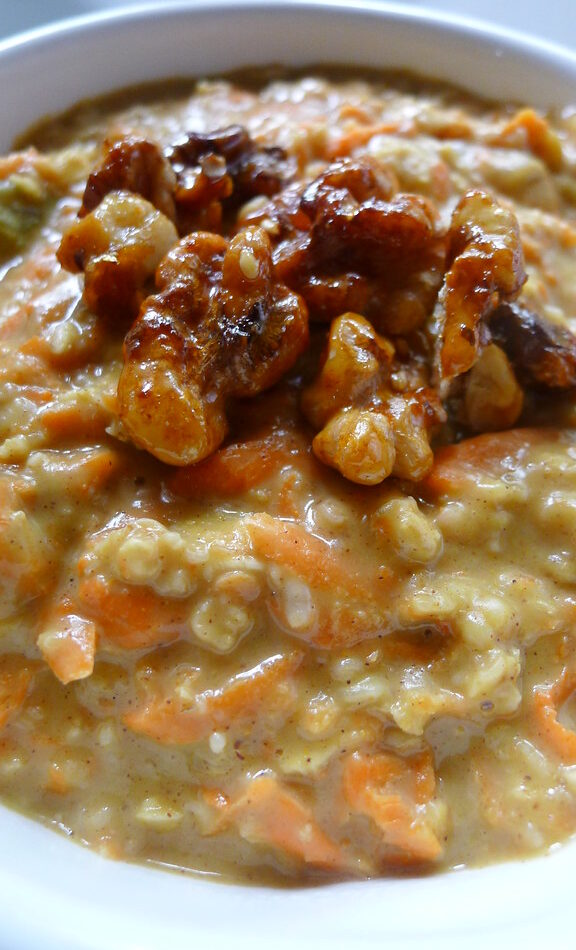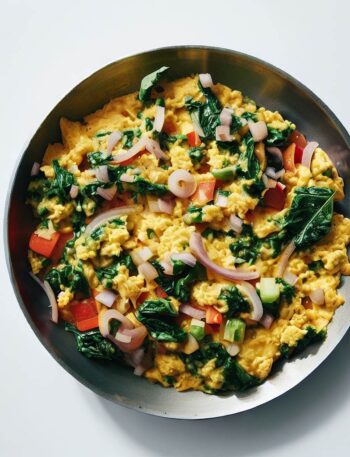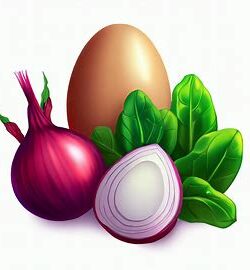Carrot Cake Oatmeal: A Deliciously Wholesome Twist on a Classic Dessert
Indulge in the delightful flavors of carrot cake in a healthier and heartwarming way with our Carrot Cake Oatmeal recipe. This breakfast delight combines the cozy comfort of oatmeal with the aromatic spices, sweetness, and earthy goodness of carrot cake. Packed with fiber, nutrients, and a hint of indulgence, this recipe is a perfect way to start your day on a deliciously wholesome note. Get ready to savor the familiar taste of carrot cake while enjoying the benefits of a nutritious and satisfying breakfast.
Ingredients:
- 1 cup old-fashioned rolled oats
- 1 cup grated carrots
- 2 cups milk (dairy or plant-based)
- 2 tablespoons maple syrup or honey
- 1/2 teaspoon ground cinnamon
- 1/4 teaspoon ground nutmeg
- 1/4 teaspoon ground ginger
- 1/4 cup raisins or chopped walnuts (optional)
- 1/4 cup cream cheese (optional, for topping)
Instructions:
Preparing the Oatmeal Base
In a medium-sized saucepan, combine the rolled oats, grated carrots, milk, maple syrup or honey, ground cinnamon, ground nutmeg, and ground ginger. Stir well to combine all the ingredients, ensuring the oats are fully submerged in the liquid.
Cooking the Oatmeal
Place the saucepan over medium heat and bring the mixture to a gentle simmer. Stir occasionally to prevent the oats from sticking to the bottom of the pan. Cook for about 5-7 minutes, or until the oats are tender and have absorbed most of the liquid. The grated carrots will soften and infuse the oatmeal with their sweet and earthy flavors.
Adding Optional Toppings
If desired, add raisins or chopped walnuts to the oatmeal during the last few minutes of cooking. These additions provide texture and a delightful contrast of flavors. Stir them into the oatmeal until well incorporated.
Serving and Topping
Once the oatmeal reaches your desired consistency, remove the saucepan from heat. Spoon the Carrot Cake Oatmeal into bowls and serve it warm. For an extra touch of indulgence, top each bowl with a dollop of cream cheese, allowing it to gently melt into the warm oatmeal. This step mimics the luscious cream cheese frosting found on traditional carrot cakes.
Customization and Variations
Feel free to personalize your Carrot Cake Oatmeal by adding other optional toppings like shredded coconut, chopped pecans, or a drizzle of additional maple syrup. These additions can enhance the flavors and provide extra texture and crunch.
Conclusion
Start your mornings on a delightful note with our Carrot Cake Oatmeal recipe, a wholesome twist on a beloved dessert. By combining the comforting goodness of oatmeal with the flavors of carrot cake, you can enjoy a satisfying and nutritious breakfast that satisfies both your taste buds and your well-being.
Embrace the sweetness of grated carrots and the warm spices that dance through each bite. With a creamy dollop of cream cheese on top, this Carrot Cake Oatmeal is a true morning treat. So, gather your ingredients, prepare your saucepan, and let the aroma of this healthy indulgence fill your kitchen.
HISTORY
The History of Oatmeal in Recipes: From Ancient Grains to Versatile Ingredient
Oatmeal, a humble grain that has been a staple in diets for centuries, has a rich history in culinary traditions around the world. From its ancient origins to its modern-day presence in a variety of recipes, oatmeal has evolved and adapted to meet the changing tastes and dietary needs of different cultures. Let’s delve into the history of oatmeal in recipes and explore its journey as a versatile ingredient.
Ancient Origins: The use of oats as a food source can be traced back thousands of years. Oats were cultivated in ancient civilizations, including Egypt and ancient Greece, where they were initially used for medicinal purposes rather than as a dietary staple. The Greeks and Romans considered oats to have healing properties and used them to treat ailments.
Oats and Oatmeal in Scotland: Oatmeal became particularly popular in Scotland, where the climate was ideal for growing oats. Oats were a reliable crop, able to withstand the harsh Scottish weather conditions. Scottish cuisine heavily relied on oats, and oatmeal porridge, also known as “porridge,” became a traditional breakfast dish and an integral part of Scottish culture.
Scottish immigrants brought their love for oatmeal to North America, where it continued to be a dietary staple among settlers. In the United States, oatmeal was commonly consumed by pioneers and was often referred to as “hasty pudding.”
Oatmeal in Recipes: Over time, oatmeal expanded its presence in culinary recipes beyond porridge. Its versatility and nutritional benefits made it a popular ingredient in various dishes across different cultures.
Baking with Oatmeal: Oatmeal’s ability to add texture, flavor, and nutritional value to baked goods led to its incorporation in bread, cookies, muffins, and cakes. Oatmeal cookies, with their chewy texture and hearty flavor, became a favorite treat. Oatmeal bread, known for its dense and nutritious qualities, offered a satisfying alternative to traditional wheat-based bread.
Savory Oatmeal Dishes: Oatmeal also found its way into savory dishes. In Scotland, oatcakes were made by combining oats, water, and sometimes butter or fat. These flatbread-like cakes were a common accompaniment to meals. Oats were also used as a thickening agent in soups, stews, and meat dishes, providing a hearty and nutritious base.
Oatmeal as a Healthy Breakfast: As awareness of the health benefits of oatmeal grew, it gained popularity as a nutritious breakfast option. Oats are rich in fiber, minerals, and antioxidants, and have been associated with various health benefits, including improved heart health and regulated blood sugar levels. Today, oatmeal is consumed in various forms, including instant oats, steel-cut oats, and rolled oats, and is often combined with fruits, nuts, and sweeteners to create a delicious and filling breakfast meal.
Modern-Day Oatmeal Variations: In recent years, the versatility of oatmeal has expanded even further. Oat milk, a dairy-free alternative to cow’s milk, has gained popularity as a plant-based beverage. It is used as a creamy ingredient in coffee, smoothies, and baking recipes. Oat flour, made by grinding oats, has become a gluten-free option for baking and cooking.
The history of oatmeal in recipes is a testament to its enduring presence in culinary traditions around the world. From its ancient origins to its modern-day variations, oatmeal has evolved to meet the changing needs and preferences of different cultures. Whether enjoyed as a comforting bowl of porridge, a crunchy oatmeal cookie, or a healthy breakfast option, oatmeal continues to be a versatile and nutritious ingredient in a wide range of recipes.


